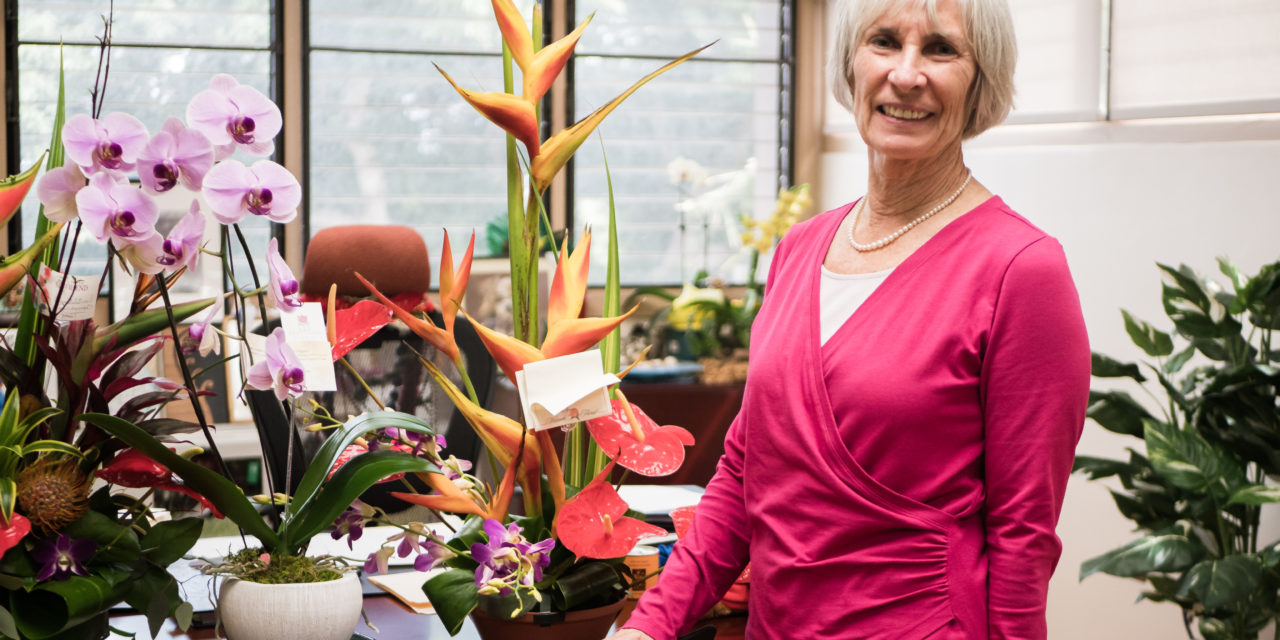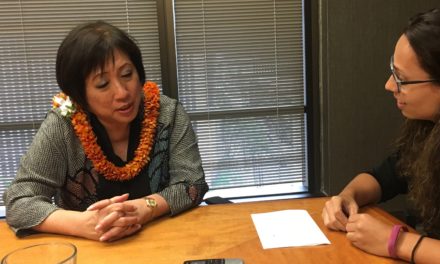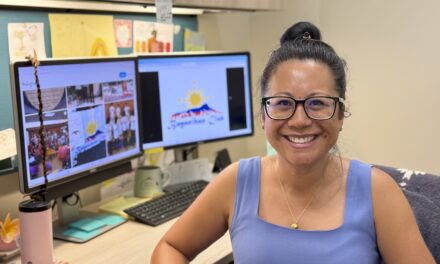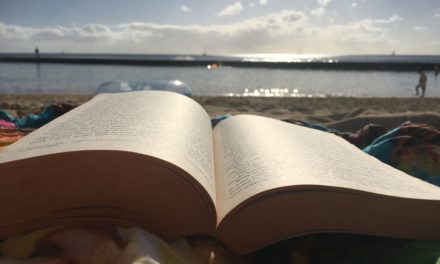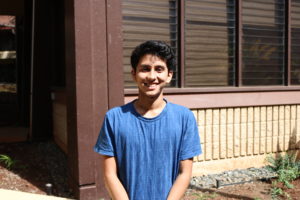By Tyrone Simmons, Jr. | Staff Writer
After navigating through an unprecedented semester that saw all classes go online only in March due to Covid-19, Kapi‘olani Community College Chancellor Louise Pagotto had a chance to talk — remotely — with staff writer Tyrone Simmons, Jr. [Note: This interview has been lightly edited for content and style.]
Simmons: So the first thing I want to ask you, as you know, we got the pandemic going on and so that’s pretty much what the article is going to be about how the college responded to the pandemic and what you guys have planned for the future, in particular the fall semester as we are supposed to be returning to in-person classes. So my first question is how do you think the college has responded to the virus or the pandemic overall?
Pagotto: I guess it was March 13th through March 23rd that was an exceedingly busy time for the faculty. What the faculty had to do in a very short time was really pivot. There were, of course, faculty who were already teaching online saying, “This is cool, we’re good.” But others who needed to change their whole delivery and learn new skills very quickly, and there were other classes that could not continue at all. Even with Zoom. There were some culinary classes, they couldn’t do a kitchen online. There were health classes that couldn’t do the clinicals online. So some classes had to push the pause button for the rest of that semester. But for what the faculty had to do in a very short time, I think, really saved the day for a lot of students. It’s not to say that students didn’t struggle too. I’ve seen some of the responses on the survey that the students are now doing. They kind of broke my heart. In some cases, they were really so thankful for the faculty’s hard work and being receptive and being communicative. Others who said the faculty kind of disappeared, [and] they were really lost. Students who said they had real trouble finding quiet places to study because of a lot of people in the house or the internet wasn’t really good. And some students didn’t know they could come to the library where it was quiet and where there was free wi-fi. We could have done a better job communicating to the students what the resources were available to them even during this lockdown.
But overall, I suspect that the students were able to do as well as they possibly could with the support of the faculty and the counselors too. I think all things considered it was as good as we could do under those circumstances and in some cases far better than anyone expected because the faculty spent a lot of time trying to get ready for that. In that Spring Break period [March 16-20], they were jamming just trying to get everything together to come back on the 23rd of March.
Simmons: Yeah it was a real quick change. So with some classes not being able to continue at all like the health classes, the culinary classes, what happened with those students? Did they receive no credit for the class, or did they receive whatever they had at the time? Or were they compensated in some type of way.
Pagotto: I think the classes are going to be completed. We just got the green light this week to bring those students back to campus making sure that we comply with all the sanitation, the social distancing, the facial coverings, to bring those students back to complete those sections. So I believe that the culinary students will be finishing their spring class in second summer session. And the health programs are trying to come back online as we speak to try to get the spring done.
Simmons: Was that always the plan from the beginning or is this something that was just thought of? And how are the students responding? Are they onboard to do that plan or are you not sure?
Pagotto: We’re trying to ascertain that right now. At the time when we had to put a pause on the classes, we weren’t sure. There’s still lots of unknowns. At the time when we paused the classes, we were not aware of how or when we were going to pick that up, only that for those students in those programs, it was really important for them to finish. They couldn’t not do that part because the faculty could not certify that they had developed the skills that they needed to develop to complete the class. So, the culinary program and all the health programs have professional accreditation, which means they are held to particular standards set by national organizations so they can’t just say, “Nah, you know let’s not do that. We’re not going to do the Roman Empire this semester.” They can’t do that. So, they must complete. So that’s where we are right now with those guys. And you know we’re just now reaching out to the students to find out can they come back now. Are they committed to something else at this time that makes it impossible for them to come back and so now we’re going to be asking, “What do we need to do to make sure the students can finish?”
Simmons: Exactly. Okay, so given what you know now, what do you wish you could change about how everything was implemented?
Pagotto: I would love another month of time to get things ready. We only had a week. I wish we had done a better job communicating the resources to students because I did see in most surveys that they didn’t know the library was available to study; they had no place to study. I know now that students didn’t know they could reach out to counselors for help. That they were struggling with time management, with discipline. I know how hard it is to do an online class, I tried it three times, and I didn’t finish. It’s really really hard to carve out the time and say, “For the next hour, I’m going to do this class and the next hour I’ll do some other class.” And so it was a real struggle for the students, and I wish that we had done a better job of supporting them and letting them know what the resources were for them.
And for the faculty, same thing, not everybody jumped into it and was able to make that pivot at that time. To give them the extra support that they needed would be great as well. But we know that going into fall it’s different, it’s not going to be emergency, and I know that expectations will be different from the students. So, the president has said that we are going to be offering face-to-face classes and then he says it’s not going to be business as usual, and so that’s where we are right now Tyrone. We’re at that very point where the faculty and the departments and the deans are working together to determine what is it that we’re going to need to do. Some classes must be face-to-face because of the nature of the work so you can imagine science labs. We had to pivot, we had to do it, but faculty aren’t necessarily prepared to do that over a 16-week semester. So those classes that must be face-to-face, what are we going to do to keep the students safe, the faculty safe, the learning environment conducive while maintaining social distance, sanitation, and facial coverings? And that is our challenge right now, how are we going to be able to do that for those classes that must be face-to-face. The other classes, we’re hoping that online classes will continue, hybrid classes should continue and my personal hope is that we can put online as much as we possibly can just because if there’s a need sometime in the fall to shut down again, we’ll be much more ready this time.
Simmons: Okay.
Pagotto: But what I also saw from the student survey is some students saying they really don’t like online classes, they really didn’t enjoy the learning, that they really really prefer face-to-face classes. And others students who said they’re really scared to come back to face-to-face classes, and they really hope that there are online classes for them to take. So we have to be able to, as best as we can, meet both of those needs for the students and the faculty too.
Simmons: And there were always online classes even before the pandemic, so I feel like for that subset of students who want to continue to take online classes that’s always been available for them. So that shouldn’t be too much of an issue. Another question I have is what do you say to the students who signed up for in-person classes and was not allowed because of the virus to take them? It’s an unfortunate situation, nobody’s fault, but a lot of the students did feel as though they were gypped in a way. Like they did not get what they paid for, in a way. What do you say to the students who feel like they weren’t compensated for having to kind of accept this online situation when in-person is what they wanted and what they paid for?
Pagotto: Yeah. And again it was a state of emergency declared by President Trump, so it wasn’t anybody’s intention. It certainly wasn’t the way we started out the semester, and I think for the students, the faculty delivered the instruction, the students learned as best as they could, and yeah it wasn’t what they signed up for, but I would say for the students who persevered, it was a struggle I understand that. They’re learning, I think, and again it wasn’t me in the classroom or online, was able to be completed. The option for the students to change from a letter grade to credit/no-credit is one way that the students can feel some compensation. Not financial compensation, but if they feel their performance wasn’t up to their standards or wasn’t what they expected, they can opt for a grade that will not impact their GPA, so changing from a letter grade no matter what the grade was. I cannot imagine that students who earned a A or a B would change to credit or no-credit, but some students who got a C or a D or an F can change their letter grade and not have it impact their GPA at all.
Simmons: Do you think that the students should have had the option to maybe withdraw from the class like once this came on? Or did they have the option? Did students have the option to withdraw without penalty?
Pagotto: Yep. The date for withdrawal was extended to [the last day of] April.
Simmons: So with the campus supposedly reopening in the fall, will we be limiting the number of students who can register for a particular class in order to promote social distancing?
Pagotto: I don’t believe that we’ll be limiting the number of people who can register for a class. We will be limiting the number of students who can be physically present in a class at any one time. So, we have to maintain 6 feet all around the students so there will be constraints on how many physical bodies can be in a classroom at any one particular time. As we will be entering and exiting the classroom, you cannot all be going out at the same time, it’s going to have to be single file, 6 feet apart.
Simmons: Okay but if there’s not enough physical space in the room to accommodate, say, 30 individuals for a particular time, will we say only 15 individuals can be in this class at this time?
Pagotto: Yes. There may be some ways that we would have to divide up the face-to-face time so that half the class comes one day, half the class comes the other day and then the rest becomes online. So those are the exact conversations that the faculty are having right now about how do we do this. How do we manage if it must be face-to-face? Or if the faculty is adamant they want to make it face-to-face, then how do we do this and maintain sanitation and safety for the students? And so what the facilities manager and the vice chancellor for administrative services have done is they’ve done an inventory on all the classrooms. They’ve measured all the classrooms; they’ve looked at the furniture, and they are determining how many students can be in this classroom and maintain social distance so that we have a sense of how many can be in there at any one time.
Simmons: So with the virus disproportionately affecting low-income students, are there any plans to adjust tuition or offer more financial aid to anyone who has been disproportionately affected?
Pagotto: Right, um. Tuition no. We don’t change tuition that quickly.
Simmons: Yeah tuition’s a hard one.
Pagotto: Yeah tuition is a hard one, but there will be aid available to students so in the spring semester students who were eligible were given an opportunity to request $200 to help. And there was the Urgent Student Relief funding that was also available for students, and there will be additional financial aid for students for the fall semester, and I would encourage all the students to complete a FAFSA form because that’s your ticket to additional financial support. It’s not financial aid, it’s separate from financial aid, but you have to qualify the same way so all the students complete a FAFSA and get their name in there.
Simmons: And when it comes to the CARES Act, how’s that going to affect student aid?
Pagotto: So there’s actually 3 CARES. CARES 1, 2 and 3. CARES 1 is the funding that was directed typically for students; all of it was to go for student aid. A portion of that CARES 1 Act funding was dispersed in the spring semester. Everybody who replied to the email got the $200. Another portion of it will be saved for fall. And that right now is what we’re going to be talking about. How is it going to be made available to the students? And so that is in progress right now. CARES 2, a second wave of funding, is available to the institutions to get ready for fall. So, what is it going to take? How many canisters of sanitizer are we going to need? How many sanitizing wipes are we going to need? All that kind of stuff. What additional technology are we going to need? So that’s CARES 2 funding. And CARES 3 funding is similar, just a different pot of money. The federal government has been very, very generous in providing support for what we might need to do to get ready for fall. The UH president [David Lassner] is very much interested in us making strategic use of this funding and thinking about how is the finding going to help move the institutions into this post-COVID delivery. He has said, and everywhere you look, it’s not going to be the same. There will be a new normal, and it’s not going to be what it was. And so, what is it going to be and how are we going to be able to prepare and how are we going to deliver it with quality? That’s our big challenge right now. And it’s kind of interesting that we are all very much in the same boat. I saw an online article about the top 25 institutions in the nation — this was 4-year institutions, all the Ivy Leagues — being asked, “What are your plans for Fall 2020?” And many of them are like, “Well, we’re just trying to figure that out right now.” And I think it was Duke University that said we’ll know in August. A little bit late.
Simmons: I know the California State University system said they’re doing online only in the fall.
Pagotto: Yeah I just heard that today too. That makes things really difficult. And to be 100 percent online, there are certain populations of students that cannot, cannot be totally online. Veterans can’t be only online, and international students cannot be only online. There are constraints.
Simmons: Yes. I would agree. I don’t know what their decision-making process was, but I feel like it was a little premature, personally. But who knows?
Pagotto: Yeah, I think if you’re looking at all of the possibilities, that will be, on the one hand, maybe the most destructive right now for the faculty and maybe the least desirable for some of the students. But going forward, it’s going to be the least disruptive if anything happens in California. … So whatever decisions are made, there is a cost somewhere. There is no one great answer. And what is sad, too, I saw one of the private institutions that is closing. They’re just shutting down. “That’s it, we’re done.”
Simmons: Yeah, I’ve seen a lot of schools in the Midwest just close their doors going bankrupt. They can’t afford it.
Pagotto: Imagine what that does to the community and all the students who are either hoping to get there or in the middle of something and now can’t finish. It’s tragic.
Simmons: It really is. Do you think that once the fall rolls around, that if we are able to go back to in-person classes, that the students will actually return in the same numbers? Or do you think that there going to still be fears of infection among the student body that’ll keep a lot of people home?
Pagotto: Yes, I think there will be an impact on student enrollments guaranteed. There are students who may not have been able to continue in their jobs and don’t have the funding to come back. There are students who will prefer not to come back because they don’t like the delivery system, they don’t like the uncertainty. There are students who will choose possibly to go some other place and say, “If I’m going to go online, I might as well go somewhere else and just stay home and do online at Arizona State University.” So, there is going to be a definite impact. On our campus, 10 percent of our student enrollment is international students. Now, are their parents going to let them come? I don’t know. They come and they have to be quarantined for two weeks right now. Are they going to come? I don’t know. The embassies are closed in South Korea, and in Japan no visas are being processed, so even if they want to come, maybe they cannot because they can’t get the right papers to travel. So, we will see a decline in international students. We will see a decline in possibly our returning students. The last time there was a big recession in 2008-2009, it took about 18 months for enrollments to start skyrocketing. Right now, there may be this lag. It might take 18 months for the economy to pick up again or for people to have the employment that they need to pay for school. There are so many unknowns, it’s really really difficult to try to determine. What we see now when we look at the data is that we have significantly fewer students enrolling and registering at this point this many days out from the first day of classes. So that’s tracked, it’s online, it’s open to the public. So the last time I checked we were 29 percent down in terms of enrollment numbers. So yes, there will be an impact for sure.
Simmons: What advice do you have for students who are trying to manage the waters, trying to plan their futures out, trying to re-determine if a college education is even worth it? What advice do you have for those students?
Pagotto: I would say for those students while the situation is immediate, it’s right here. I think students need to look a little bit longer term to see where they might want to put their energies. We know all of the social determinates of education are positive. We know college-educated individuals have more job security, they earn more, they’re heathier, they have better retirements, … but it does lead to a different kind of life. And I think students should really think about what kind of life they want to have going forward. And what is it going to take for them to have that kind of life. And to speak with the faculty that they feel close to, to speak with the counselors about what are [the] possibilities, … to speak to those folks who can help connect them with the resources [so] that they’re not alone in trying to make this call. And that if they choose to take a break from school, that they make a promise to themselves to come back. Write it on a piece of paper, put it in your drawer, or underneath all of your clothing and just say, “I know right now it’s not the right time.” And it’s not going to be the right time for some people but to make a promise to yourself to come back. And if it is possible to come back then reach out to those folks who can help and come back to Kapiʻolani because we’re going to be here for students.
Simmons: I’m still in the military right now, but I’m getting ready to leave the service in August and so I’m going to be going to school full-time starting in August, but even though I have pretty much financial security with the Post-9/11 GI bill, it’s still hard trying to navigate everything when it comes to in-person classes, when it comes to online, and when it comes to some schools closing down, maybe not even being open so I can only imagine what it’s like for people who have to add the financial aspect into it and the other things.
Pagotto: Yeah there are some really difficult decisions that will need to be made by every single student going forward. Even folks who may have the finances through whatever means, they have to decide “Is this right for me?” Or “What is going to be right for me?” What are the possibilities, and we’re committed to getting that information to the students as soon as we can. And we’re hoping to have everything locked down, that is the fall semester, figured out before June 1st. That is our target date and the faculty and the departments and the deans are working really hard to really get that solid so that students have the information that they need to make the decisions they need to make for the fall.
Simmons: That’s good I think that puts UH ahead of most college systems out there. Most of them have no idea about what’s going on.
Pagotto: Yes, we’re all trying to figure this out. Every single institution is trying to figure this out.

